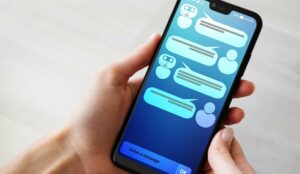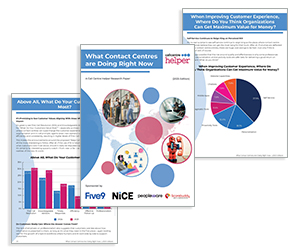Chatbots are designed to interact with users in a way that mimics human conversation. They are used for tasks like answering customer queries, providing information, or guiding users through a process.
While some chatbots operate using simple rule-based systems, more advanced versions use artificial intelligence (AI) to understand and respond to natural language.
To find out more, we asked Angela Lepelley, Sales Director – AI & Automation EMEA at Five9, and Steven Harris, Director, Strategic Clients at Odigo, to describe how chatbots work.
Video: How Do Chatbots Work?
Watch the video below to hear Angela and Steven describe how chatbots work:
With thanks to the following people for contributing to this video:
- Angela Lepelley, Sales Director – AI & Automation EMEA at Five9
- Steven Harris, Director, Strategic Clients at Odigo
Understanding Chatbot Functionality
A chatbot works by taking inputs from a user – either through text or voice – and generating an appropriate response, as Angela explains:
“For me a chatbot is essentially just a computer program that’s taking actions, specific inputs and triggers to complete the task through a human conversation.
So ultimately you have a user, who communicates with the chatbot through a user interface. This can be a chat interface, messaging application, or via voice. And you speak to that chatbot just like you would another person.
And then the chatbot interprets those words given to them by the user and then provides an answer and a response back to the user. I think it’s how we interpret these words and extract meaning out of them that’s important.”
Basic chatbots rely on pre-set responses based on keyword detection or menu selections.
More advanced AI-powered chatbots analyse natural language to understand meaning, intent, and context before formulating a response.
The Four Key Stages of a Chatbot’s Process
According to Steven:
“Chatbots are used to answer queries, provide information or help you through a process such as booking travel. And I think the same as people, they go through four stages.”
So lets take a look at these four main stages:
1. Understanding the Query
The chatbot first interprets the user’s request. It analyses words, sentence structure, and context using natural language processing (NLP) techniques.
“First they make sure they understand the request, they analyse the words using statistical techniques and so on. Then, like us, they have the ability to learn and get better at understanding.” – Steven
2. Gathering Relevant Data
Once the request is understood, the chatbot retrieves necessary information. This could include customer details, previous interactions, or product information, as Steven explains:
“Second, they then gather any relevant data. So maybe a customer’s account details, an outstanding order, product information, whatever is appropriate to the query.”
3. Determining a Response
Using the gathered data, the chatbot selects the most appropriate response from a library of possible answers.
“Third, they use all of this to determine the type of response and they’ll typically have a library of options to do that.
And then obviously they can incorporate the specific information that they’ve gathered where it’s needed to answer the query.” – Steven
In AI-driven systems, machine learning helps improve this process over time.
4. Delivering the Response
The chatbot provides the answer to the user. This may be a direct reply, a request for more information, or, in some cases, a transfer to a human agent if the request is too complex.
“Fourth, they then deliver a response. That could be an answer, it could be a request for clarification information, it could be a request for the next piece of information needed to go through a process.
And I guess in some cases they recognize they can’t handle a request and they put you through to a human being.” – Steven
The Role of AI in Modern Chatbots
Unlike traditional rule-based chatbots, AI-powered chatbots can handle more complex conversations.
“There’s a distinction between the simple rule-based bots, where you’re clicking buttons and choosing from options and relevant answers.
These are based on basic pattern matching and keyword spotting, and there’s often only just kind of preset answers to these.
But the distinction between those and now what we’re moving to in today’s chatbots, which are AI powered, is really the ability to use free language and speak naturally. And that’s where we need the more sophisticated algorithms and capability.” – Angela
They can understand natural speech, adapt to different phrasing, and improve over time through learning. This makes them more effective for customer support, sales, and other business applications.
As chatbot technology continues to evolve, businesses are increasingly using them to automate interactions and improve customer experiences.
If you are looking for more great insights from the experts, check out these next:
- When to Move from Spreadsheets to WFM
- Understanding Speech Analytics
- One Simple Way to Motivate Staff
- A Quick Introduction to WFM
Author: Robyn Coppell
Reviewed by: Hannah Swankie
Published On: 6th Jun 2022 - Last modified: 25th Sep 2025
Read more about - Video, Angela Lepelley, Artificial Intelligence (AI), Chatbots, Customer Service, Five9, Odigo, Steven Harris, Videos
















